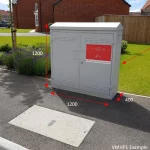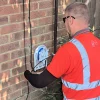Vodafone UK Finally Adds 4G LTE-M Network Support for IoT Devices

Mobile operator Vodafone UK has announced that their national 4G (mobile broadband) network can now support the Long Term Evolution for Machines (LTE-M or CAT-M) standard, which is a type of Low Power Wide Area Network (LPWAN) service that can connect Internet of Things (IoT) devices.
Such networks tend to only use a tiny amount of spectrum bandwidth (often just 1.4 – 5MHz) in order to deliver fairly slow mobile data speeds (often sub-1Mbps, although they can go up to 7Mbps), albeit with wide geographic coverage. But this is largely irrelevant since the small IoT kit that LTE-M is designed to connect usually only require speeds of 0.1Mbps+ (e.g. traffic lights, environment sensors, asset tracking etc.) and are often battery powered.
The new offering is designed to sit alongside Vodafone’s existing 4G, 5G and Narrowband-IoT services (NB-IoT), as well as the wider partner ecosystem, to enable Vodafone to work with any business irrelevant of the technical requirements of the IoT use case (i.e. not all IoT devices are designed to use the same communication technologies).
Advertisement
Take note that NB-IoT is a separate but similar technology. Vodafone states that LTE-M and NB-IoT differ through the “typical download/upload speeds (300kbps and 20kbps respectively)“, while NB-IoT is optimised for difficult to reach locations and batch data upload (such as underground water pipes or smart meters in basements), and LTE-M for mobility (such as asset tracking and wearable devices) or event-based connectivity.
Nick Gliddon, Business Director of Vodafone UK, said:
“When you have a data-led business, decisions are driven by insight not by assumption. IoT has the potential to revolutionise business, but we must make it accessible to all.
The power of LTE-M is the ability to choose the right tools for the right job. 5G might be the right choice for some IoT use cases, whereas LTE-M might be better for others. By enabling LTE-M to sit alongside 4G, 5G and NB-IoT, we are providing a technology-agnostic solution for customers. This is about picking the right solution, at the right price point.”
However, it’s worth noting that Vodafone are a little late to the LTE-M party, since other network operators (e.g. O2) have been supporting it for several years.
Mark is a professional technology writer, IT consultant and computer engineer from Dorset (England), he also founded ISPreview in 1999 and enjoys analysing the latest telecoms and broadband developments. Find me on X (Twitter), Mastodon, Facebook, BlueSky, Threads.net and Linkedin.
« Starlink Broadband Launch Mini Dish and Mini Roam Service in UK























































But can you run it as an ipv6 service, so that you’ve got portability across networks?
This is great but can Vodafone open up their IMS so all 4G phones can use VoLTE instead of restricting it to approved phones only that way they can actually move away from 2G